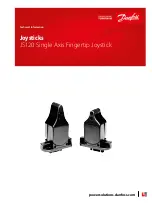
© MOOG 2019
This document is subject to MOOG INTELLECTUAL AND PROPRIETARY INFORMATION LEGEND . The details are on page II.
11
MRJ06301
Figure 1-7 Actuator
– Die Gap Tooling Mechanical Adjustment
1-5-2. TOOLING ADJUSTMENT
When a mold change is made, it is often necessary to
change the die gap tooling assembly. Therefore the actu-
ator installation must provide for simple adjustment of the
die gap tooling position relative to the actuator position.
Figure 1-7 shows two possible methods of adjusting the
positional relationship between the tooling actuator and
the die gap tooling’s closed position. Tooling motion stops
may be required to limit the forces on the die gap tooling
when the die and mandrel touch. Figure 1-8 is a typical
installation.
Some actuators with an anti-rotation fea-
ture require the nut torque loads on the
anti-rotation device to be limited by ab-
sorbing the tightening torque with a
wrench on the actuator rod flats
Tooling stops are required to insure a die gap that cannot close on a continuous molding machine. An
inadvertent closure of the die gap could cause very high pressures in the extruder barrel and extrusion
head and result in their damage and/or failure.
The above comments must be considered for the proper installation of either a Moog supplied die gap
tooling actuator or a customer supplied actuator.
Figure 1-8 Tooling Adjustment Mechanism
Die Gap
Adjust-
ment
Collar
Lock
Nuts
















































